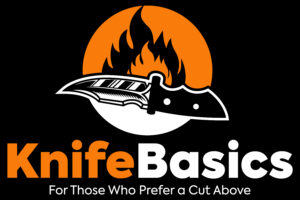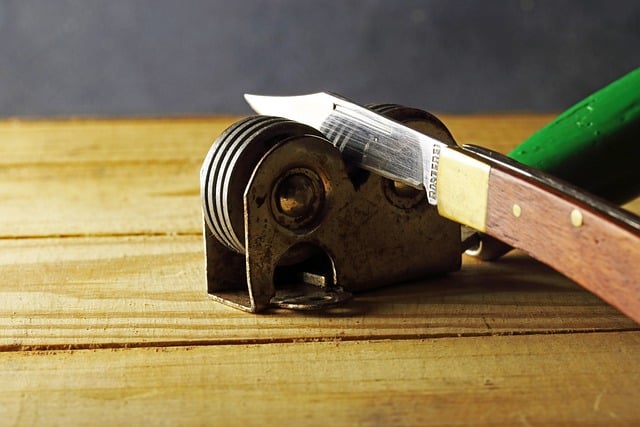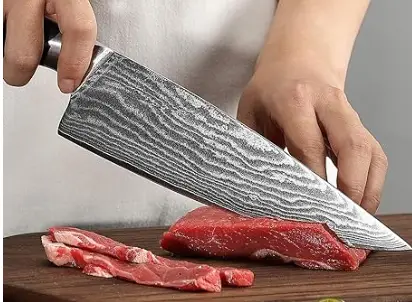Are you having trouble skinning wildlife using your present knife? Look no further—we have the best advice available to assist you in selecting the ideal knife for flawlessly precise skinning.
Having the correct knife can make all the difference while skinning. Every little detail matters, from the handle design to the blade material. In order to help you make an informed choice, our guide will take you through all of the important things to take into account when choosing a skinning knife.
Super Knife Steel: Exploring the Science of its Superior Strength
We are aware that every hunter has different needs and preferences. For this reason, we have put together a list of our best picks that address a variety of requirements. We have you covered whether you’re a novice searching for an affordable solution or an experienced professional seeking the best quality.
Put an end to your frustration and poor performance today. With the help of our knowledgeable guidance, you will be able to select the ideal knife for skinning and make flawless cuts every time. Bid farewell to inconsistent skinning and welcome to smooth performance. Now let’s get started and locate the ideal skinning knife for you!
Skinning Knife Types
There are various varieties of skinning knives available, each with pros and cons of their own. Knowing the many varieties will enable you to focus your choices and make the best decision for your requirements.
1. Drop Point: One of the most used blade types for skinning knives is the drop point blade. It is great for making precise cuts and reduces the chance of puncturing the hide or contaminating the meat because of its curved edge and lowered tip. This blade form is adaptable and good for many different types of game.
2. Gut Hook: The spine of a gut hook knife is equipped with a tiny, sharpened hook. Because of its design, gutting is simple and effective without running the risk of piercing internal organs. Gut hooks are great for hunters who often process their own wildlife; they are specifically made for field dressing, albeit they are not as flexible as drop point knives.
3. Skinner: Knives made especially for skinning wildlife are called skinners. Their broad, sweeping blades, which have a sharp point and a curved edge, enable effective skinning in a single stroke. Skinners are skilled in swiftly extracting hides without causing any harm to the meat underneath.
Things to Take Into Account Before Purchasing a Skinning Knife
When choosing a skinning knife, there are a number of factors to take into account. You need to make sure that the knife you’ve selected satisfies your unique needs by considering these variables.
1. Blade Length: When selecting a skinning knife, the blade length is a crucial factor to take into account. Larger game responds better to longer blades because they make cuts more effectively. Shorter blades, on the other hand, are perfect for smaller game since they provide more control and flexibility.
2. Blade Thickness: The blade’s longevity and cutting efficiency are influenced by its thickness. Although thicker blades are more resilient and able to handle demanding jobs, they might not be as accurate. Although they offer more control and accuracy, thinner blades may be more prone to breakage.
3. Handle Design: Comfort and grip are greatly influenced by the handle design. Seek for ergonomically designed handles composed of premium materials like rubber, wood, or synthetic composites. Make sure the handle is pleasant and secure to grip, even in slick or damp conditions.
4. Weight and Balance: A skinning knife’s weight and balance have a big influence on how well it works. Your comfort level with weight has an impact on your ability to maneuver and how tired you get after extended use. A knife that is properly balanced will provide you the best control and won’t strain your hands.
5. Durability and Maintenance: Because skinning knives are subjected to severe environments and frequent use, they must be durable. Select knives with high-quality construction that will hold up against demanding uses without sacrificing their integrity or sharpness. Take into account how simple it is to maintain and sharpen your knife in order to keep it in top shape.
Related article: The Beauty and Performance of the Damascus Knife
Materials for Knives with Blades
An important consideration when evaluating a skinning knife’s durability, sharpness, and quality is the substance of the blade. The levels of hardness, corrosion resistance, and edge retention differ throughout materials. The following are some typical materials for skinning knife blades:
1. Stainless Steel: Because of its resistance to corrosion and ease of upkeep, stainless steel blades are widely used. They can be used in damp or humid conditions since they are less likely to rust and stain. But compared to other materials, stainless steel blades might need to be sharpened more frequently.
2. Carbon Steel: Blades made of carbon steel are renowned for their remarkable sharpness and edge holding. They are perfect for precise cutting since they keep their edge well and are simple to sharpen. However, carbon steel blades need more frequent maintenance to avoid rust because they are more prone to corrosion.
3. High-Carbon Stainless Steel: High-carbon stainless steel blades combine the qualities of stainless steel, which resist corrosion, with the sharpness and edge retention of carbon steel. Hunters favor these blades because they combine durability and performance in a pleasing way.
4. Ceramic: Blades made of ceramic are extremely sharp and have a lengthy edge retention period. In addition, they are corrosion-resistant and lightweight. However, if handled incorrectly or pushed to extreme force, ceramic blades are brittle and easily chipped or broken. They need certain tools and methods for sharpening.
Manage Knife-Skinning Materials
The comfort, durability, and grip of a skinning knife are all influenced by the material of the handle. There are differences in the stability, moisture resistance, and texture of different handle materials. The following are some typical materials used for skinning knife handles:
1. Wood: Due to its inherent warmth and beauty, wood handles are very popular. In addition to offering a conventional and cozy grip, they also absorb moisture. Nonetheless, frequent upkeep is necessary to keep wood handles from rotting, warping, or cracking from moisture exposure.
2. Rubber: In damp or slick circumstances, rubber handles provide superior grip and stress absorption. For hunters who like a non-slip handle, they are perfect since they are easy to hold and offer a stable grip. Rubber handles are also simple to maintain and clean.
3. Synthetic Composites: Materials for handles made of synthetics, including G10, Micarta, or FRN (Fiberglass Reinforced Nylon), combine strength, light weight, and resistance to moisture. They are appropriate for rough outdoor use because they are resistant to impact, chemicals, and temperature fluctuations.
4. Stainless Steel: The sturdy and corrosion-resistant handles of certain skinning knives are made of stainless steel. Although stainless steel handles are simple to keep clean, they might not have the same comfort and grip as handles made of other materials. Stainless steel handles with contours or textures can enhance grip.
What is the Best Stainless Steel for Knife Making?
Shapes of Blades
A skinning knife’s cutting effectiveness, versatility, and ease of usage are all determined by the shape of its blade. Understanding the features of different blade shapes will help you select the best one for your requirements. Different blade shapes perform better in different activities. The following are some typical blade forms found on skinning knives:
1. Drop Point: As previously said, drop point blades are adaptable and suitable for a range of games. They are perfect for controlled skinning and precision cutting without piercing the hide or causing damage to the meat because of their lowered tip and curved edge.
2. Clip Point: The spine of clip point blades has a concave curvature that ends in a sharp, fine tip. This blade form works well for fine tasks like cutting through thin membranes or getting around bones. For larger wildlife, clip point knives could be less effective.
3. Trailing Point: To provide a greater cutting surface, trailing point blades have a sharp upward bend along their spine. This form is perfect for skinning huge game or creating precise, controlled slices since it allows for long, sweeping cuts. Trailing point blades, however, might take more expertise to use properly.
4. Straight: From the spine to the tip, the edge of a straight blade is straightforward and straight. Straight blades are excellent at creating neat, accurate cuts, but they are not as adaptable as other blade forms. They are in especially handy when it comes to taking the hides off of smaller game or doing complicated skinning jobs.
The Best Knife for Skinning Suggestions
Now that you are aware of the important variables to take into account and the range of possibilities accessible, let’s look at some of the top skinning knife suggestions available. To make sure you get the ideal knife for your needs, we have carefully chosen these options based on factors including performance, durability, and user feedback.
Maintenance and Upkeep for Skinning Knives
Good maintenance and care are crucial if you want your skinning knife to last a long time and function at its best. You can keep your knife in top shape and be prepared for any skinning activity by using these tips:
1. Cleaning: usage warm water and a mild soap to clean your skinning knife after each usage. Steer clear of abrasive sponges and aggressive chemicals as they can harm the handle or blade. Dry the knife completely to avoid corrosion or rust.
2. Sharpening: To keep your skinning knife cutting as well as it should, regularly sharpen it. Make use of an expert knife sharpener, an honing rod, or a sharpening stone. When sharpening, according to the manufacturer’s guidelines and keep the angle constant.
3. Storage: Keep your skinning knife somewhere safe, dry, and hygienic. To shield the knife from harm and stop unintentional wounds, think about utilizing a sheath or guard. Keep your knife out of places with high humidity or heat.
4. Oil and Lubrication: To avoid rust and guarantee smooth opening and shutting, lightly coat the blade and pivot points with food-grade oil or lubricant. Before using the knife, make sure to remove any extra oil.
Professional Advice for Using a Skinning Knife Efficiently
You may improve the efficiency and accuracy of your skinning knife by doing the following expert advice, in addition to selecting the appropriate knife and caring for it properly:
1. Safety First: When using a skinning knife, safety should always come first. Prevent mishaps and injuries by using the proper grip and cutting technique. Cut away from your body while keeping your fingers away from the blade.
2. Maintain a Sharp Blade: Regularly sharpen your knife and hone the edge before each usage to make skinning easier and more accurate. Because dull blades demand more effort, there is a higher chance of accidents or injury.
3. Take Your Time: Precision and patience are necessary while skinning. Take your time and make careful, deliberate cuts. Rushing might result in errors or uneven skinning, which lowers the meat and hide quality.
4. Improve Your Grip: Try out a variety of grips to see which one gives you the most control and comfort. Make sure your grasp provides a firm hold without limiting your range of motion or wearing you out.
In summary
It’s important to make an informed decision when selecting the best knife for skinning. You can make an educated decision that meets your needs by taking into account the aspects covered in this article. When choosing a skinning knife, keep in mind to put quality, dependability, and functionality first.
You should also always maintain and care for the knife properly. Possessing the appropriate knife and understanding how to use it efficiently will put you in a position to accomplish any skinning operation with flawless precision. Cheers to your successful search!
- POCKET KNIFE WITH RAZOR-SHARP REPLACEABLE BLADES – Replacing blades is quick and effortless! Whenever a blade becomes dull, simply remove it and insert a new one with a razor-sharp edge. This EDC knife is perfect for everyday use or as a hunting knife to skin and field dress your deer.
- TOP-QUALITY REPLACEMENT BLADES – Our replacement blades are crafted of high-quality stainless steel, featuring a razor-sharp edge that cuts with ease. These blades undergo precise heat treatment, ensuring excellent edge retention. Every knife comes with 6 blades and extra blade packs are available for separate purchase.
- STRONG BLADE HOLDER -- The blade holder is constructed from resilient 420J2 stainless steel and features a high-quality black oxide coating. This combination offers the durability of a traditional knife and the accuracy of a surgeon's scalpel.
- NON-SLIP HANDLE AND POCKET CLIP – This knife boasts a robust yet lightweight Grivory fiberglass/nylon polymer frame with a non-slip rubberized TPR grip. Additionally, it comes equipped with a sturdy stainless-steel pocket clip, ensuring that the knife is always easily accessible.
- SERVICE FOR LIFE – At Outdoor Edge, we take pride in crafting durable cutting tools that stand the test of time. If you encounter any issues with your Outdoor Edge knife, please don't hesitate to reach out to us. We are committed to addressing all replacement and service requests promptly and effectively.
- COMPLETE 6-PIECE FIXED BLADE HUNTING KNIFE SET – This field processing set includes the six essential tools that help butcher wild game with expertise. It includes a gutting and skinning knife, caping knife, boning knife, game cleaning gloves, and a two-stage carbide/ceramic sharpener, which keeps the edge razor-sharp. The entire knife set comes in a lightweight and compact hard-side field carry case. It is perfect for butchering deer, elk, caribou, poultry, and much more.
- RAZOR SHARP KNIVES – This field dressing kit for deer and elk boasts razor-sharp knives that are perfectly balanced. The full-tang 420J2 stainless steel blades undergo precise heat treatment, taper grounding, and hand finishing to achieve a shaving sharp edge, resulting in superior edge retention and performance. The WildLite is a perfect choice for hunting gifts for men
- RUBBERIZED NONSLIP TPR HANDLES – Ergonomically shaped, high visibility blaze-orange TPR handles reduce hand fatigue after long periods of use and ensure a safe and comfortable grip, even in the slickest conditions.
- LIGHTWEIGHT COMPACT HARD-SIDE FIELD CARRY CASE – This butcher knife set comes with a convenient, compact, and lightweight hard-side field carry case. All the tools fit snugly in their designated slots, ensuring that they remain clean, dry, and well-organized, making them easy to access during your hunting trip. Its portability makes it the perfect addition to your field hunting gear backpack. Hunting accessories for men and women.
- SERVICE FOR LIFE – Outdoor Edge produces quality tools that are built to last. If you have a problem with your Outdoor Edge knife contact us. We address all replacement and service requests.





